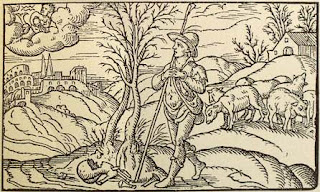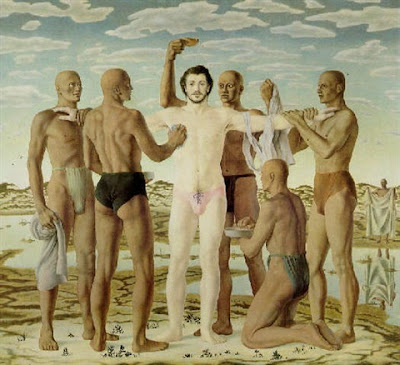Marechera and Beckett.

I begin to wonder about the imminent canonisation of St Dambudzo. A lot of criticism and adulation focus on the radical, the enfant terrible, the creative terrorist. Rather like Milton’s Satan, Marechera (in the growing, popular image) stands and denies his point of creation. Where was it then? Time? Place? Witnesses? He is an artist without lineage…simply original. He is. Such is an odd view. Marechera was a very well read author and all kinds of influences are present within his fiction.
In 1982, Marechera returned to Zimbabwe. The sequence of stories in Scrapiron Blues, Tony Fights Tonight, were written, so it is suspected, shortly after his return. These stories are contemporary with Throne of Bayonets, a quartet of poems mixing free-verse, with rhyme and formal stanzas. The subject matter of Throne of Bayonets is Zimbabwe—more specifically, Harare, which stands as a world-in-a-city, like London in The Wasteland— but the technique arises from Eliot and Africa’s Eliot, Okigbo. Just as the poem straddles the African-European divide, so does Tony Fights Tonight. The shadow of the African Trickster is cast like an early morning shadow. And the subject matter—Harare—is given substance through Beckett.
Tony Fights Tonight is a set of 11 short episodes. Sub-titled “Pub Stories”, these sections draw upon the pub as a setting for outrageous yarns, exactly the right place for Fred, the single-eyed Cyclopean Trickster to tell his sexual tales to the tricky Marechera-Odysseus. His carnival sexual tales are Marechera's version of the double-edged and eloquent signifying monkey. As the narrator of the series notes about Harare’s street mythology:
“There is always the touch of conmanship in the telling of them.” (TFT, p.3).
And in a line of pure Beckett:
“So much time to kill. So little time in which to kill it.” (TFT, p.2).
Structurally, Tony Fights Tonight appears like this:
1) Fred.
2) Tony and Jane
3) Tony and Jane
4) Fred
5) Jane
6) Tony
7) Fred
8) Fred (and Jill)
9) Narrator
10) Fred
11) Narrator
True to form, Marechera creates a patterned fictive fiction of stories within stories. There is an author who is narrating. Fred is part of that narration, but Fred becomes a narrator within the overall narrative. Tony and Jane are characters created by the author, but (as in Beckett) they are characters who show their strings. They are puppets to the authorial puppet-master, Lucky to Pozzo, but they fight for individuation, for creative liberation and their own rights. At the close of Tony Fights Tonight, Marechera refers to his two main characters as joined identities: “I knew Tonyjane were out there somewhere…” They have become an androgyne, two in one, yet they are bound to a verb in the plural “were”. There is always the potential for them to split and become something else. This follows Beckett very closely. “Tonyjane” are a “pseudocouple”, a joint creative fantasy, like Mercier and Camier (MAC, 1974, English translation). Marechera is writing in the world of Beckett’s Trilogy, which received a major re-print in 1979 and would have been a key text for Marechera at an important time of his life:
“I naturally though of the pseudocouple Mercier-Camier”. (Trilogy, p.272).
Characters revolve within the narrator’s head. The world and the book have fused such that they are inseparable and all they can do, the only truth they can tell relates to fictiveness. At the centre, in “What Available Reality”, the narrator/Marechera (?) raises the ultimate doubt:
“Was I myself a character in someone’s head? I resolved to get sickeningly drunk.” (TFT, p.17)
And this doubt comes after the narrator realises that Jane is a succubus of his imagination…a sexual partner for the author; alas, poor Tony!
The style of Tony Fights Tonight is Marecheran: gutsy, down-to-earth, sordid description shot through with lyricism, realism mixed with Symbolist imagery. But the framework is Beckett.
Dreams occupy a key place in Beckett. They are forbidden. Something like a fetish that must not be touched. In Mercier and Camier, the two characters have a “covenant”: “no communication of dreams on any account.” (MAC, p.61). Dreams, within Foucault’s clinical perspective, structurally tell the future and are bound to social order. They suggest a purpose in time, an aligning agent. Dreams carry a similar resonance for Jane, in Tony Fights Tonight. And the Existentialist echo recalls Beckett once more:
“There were so many queer dreams that attacked Jane from all sides. It was some how unfair. These were not her dreams. When she stopped to buy a paper, the white newsvendor’s dream hit her squarely on the jaw…Hell is other people.” (TFT, p.13).
"L'enfer, c'est les autres" says the narrator, about Jane, via a quotation from Satre. The dreams of others press on people such that individuals come to know themselves from outside. Dreams alienate…in the book (like Tony who must bear the dream of his author)…in the world, such that we have “nothing to say, no words but the words of others…” (Trilogy, p.288). No Exit from the dreams of others is the world’s nightmare. Dreams, for Jane, are a physical reality. She feels them as an unpremeditated attack. Jane walks through a Babel of dreams, not unconscious dreams, but conscious ones that seek to destroy the self. Marechera suggests that her walking among the dreams of others is a kind of border-line act, a stepping between worlds, that must be undertaken in the name of healing. An Hermetic wandering among the living dead in search of realness.
Tony Fights Tonight is a fascinating exploration of the nature of fiction and reality, a descent into the Inferno, with Beckett as Virgil.
In 1982, Marechera returned to Zimbabwe. The sequence of stories in Scrapiron Blues, Tony Fights Tonight, were written, so it is suspected, shortly after his return. These stories are contemporary with Throne of Bayonets, a quartet of poems mixing free-verse, with rhyme and formal stanzas. The subject matter of Throne of Bayonets is Zimbabwe—more specifically, Harare, which stands as a world-in-a-city, like London in The Wasteland— but the technique arises from Eliot and Africa’s Eliot, Okigbo. Just as the poem straddles the African-European divide, so does Tony Fights Tonight. The shadow of the African Trickster is cast like an early morning shadow. And the subject matter—Harare—is given substance through Beckett.
Tony Fights Tonight is a set of 11 short episodes. Sub-titled “Pub Stories”, these sections draw upon the pub as a setting for outrageous yarns, exactly the right place for Fred, the single-eyed Cyclopean Trickster to tell his sexual tales to the tricky Marechera-Odysseus. His carnival sexual tales are Marechera's version of the double-edged and eloquent signifying monkey. As the narrator of the series notes about Harare’s street mythology:
“There is always the touch of conmanship in the telling of them.” (TFT, p.3).
And in a line of pure Beckett:
“So much time to kill. So little time in which to kill it.” (TFT, p.2).
Structurally, Tony Fights Tonight appears like this:
1) Fred.
2) Tony and Jane
3) Tony and Jane
4) Fred
5) Jane
6) Tony
7) Fred
8) Fred (and Jill)
9) Narrator
10) Fred
11) Narrator
True to form, Marechera creates a patterned fictive fiction of stories within stories. There is an author who is narrating. Fred is part of that narration, but Fred becomes a narrator within the overall narrative. Tony and Jane are characters created by the author, but (as in Beckett) they are characters who show their strings. They are puppets to the authorial puppet-master, Lucky to Pozzo, but they fight for individuation, for creative liberation and their own rights. At the close of Tony Fights Tonight, Marechera refers to his two main characters as joined identities: “I knew Tonyjane were out there somewhere…” They have become an androgyne, two in one, yet they are bound to a verb in the plural “were”. There is always the potential for them to split and become something else. This follows Beckett very closely. “Tonyjane” are a “pseudocouple”, a joint creative fantasy, like Mercier and Camier (MAC, 1974, English translation). Marechera is writing in the world of Beckett’s Trilogy, which received a major re-print in 1979 and would have been a key text for Marechera at an important time of his life:
“I naturally though of the pseudocouple Mercier-Camier”. (Trilogy, p.272).
Characters revolve within the narrator’s head. The world and the book have fused such that they are inseparable and all they can do, the only truth they can tell relates to fictiveness. At the centre, in “What Available Reality”, the narrator/Marechera (?) raises the ultimate doubt:
“Was I myself a character in someone’s head? I resolved to get sickeningly drunk.” (TFT, p.17)
And this doubt comes after the narrator realises that Jane is a succubus of his imagination…a sexual partner for the author; alas, poor Tony!
The style of Tony Fights Tonight is Marecheran: gutsy, down-to-earth, sordid description shot through with lyricism, realism mixed with Symbolist imagery. But the framework is Beckett.
Dreams occupy a key place in Beckett. They are forbidden. Something like a fetish that must not be touched. In Mercier and Camier, the two characters have a “covenant”: “no communication of dreams on any account.” (MAC, p.61). Dreams, within Foucault’s clinical perspective, structurally tell the future and are bound to social order. They suggest a purpose in time, an aligning agent. Dreams carry a similar resonance for Jane, in Tony Fights Tonight. And the Existentialist echo recalls Beckett once more:
“There were so many queer dreams that attacked Jane from all sides. It was some how unfair. These were not her dreams. When she stopped to buy a paper, the white newsvendor’s dream hit her squarely on the jaw…Hell is other people.” (TFT, p.13).
"L'enfer, c'est les autres" says the narrator, about Jane, via a quotation from Satre. The dreams of others press on people such that individuals come to know themselves from outside. Dreams alienate…in the book (like Tony who must bear the dream of his author)…in the world, such that we have “nothing to say, no words but the words of others…” (Trilogy, p.288). No Exit from the dreams of others is the world’s nightmare. Dreams, for Jane, are a physical reality. She feels them as an unpremeditated attack. Jane walks through a Babel of dreams, not unconscious dreams, but conscious ones that seek to destroy the self. Marechera suggests that her walking among the dreams of others is a kind of border-line act, a stepping between worlds, that must be undertaken in the name of healing. An Hermetic wandering among the living dead in search of realness.
Tony Fights Tonight is a fascinating exploration of the nature of fiction and reality, a descent into the Inferno, with Beckett as Virgil.



Comments